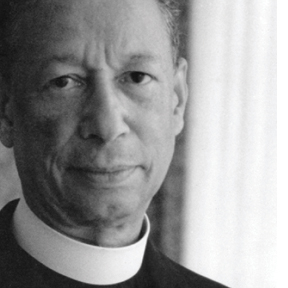Fr. Canon Jesse F. Anderson, Sr
Fourteenth Rector (1944-1975)...

After Fr. Bagnall’s death in August of 1943, with World War II continuing to rage, the vestry set about the process of calling a new rector. It is unclear if the process for calling a new rector then was the same as it is today. The vestry minutes for part of this period are missing. There is no indication that a search committee was convened or that any other body made recommendations to the vestry about potentially suitable candidates. In a letter that is part of the diocesan archival repository, dated March 17, 1944, the clerk of the vestry, Harold G. Trulear, on behalf of the vestry, informed the Bishop of Pennsylvania The Rt. Rev. Oliver J. Hart, that St. Thomas’ vestry had resolved to “consider Rev. Jesse F. Anderson [Sr.] … as [St. Thomas’] next rector to succeed the late Rev. Robert W. Bagnall.” The vestry vote naming Fr. Anderson had not been unanimous. Only ten vestrymen had voted and nine were in favor of calling Fr. Anderson and one was opposed. Harold Trulear wrote Bishop Hart “[Fr. Anderson] now becomes our candidate” and we “trust our decision will be satisfactory to you and that we may be successful in obtaining him which is the wish of the great majority of the Vestry and congregation.”
Jesse F. Anderson, a native of Plainfield, New Jersey grew up in St. Philip’s Church, Harlem where he sang on the choir and served as an acolyte. Older members reflecting on Fr. Anderson’s time as a youth at St. Philip’s said “We still remember his fine bass in the choir after his voice had changed.” He graduated from Lincoln University in 1932 and graduated from General Theological Seminary in 1935. Jesse Anderson was ordained to the diaconate in the Cathedral of St. John the Divine on Trinity Sunday 1935. Deacon Anderson was ordained to the priesthood on Trinity Sunday 1936. Thereafter The Rev. Fr. Jesse F. Anderson served St. Philip’s as curate and as Director of Religious Education. In February 1938 Fr. Anderson and his wife Penny moved to Michigan with their one-year old son Jesse, Jr. when Fr. Anderson accepted a call to be rector of St. Philip’s Church, Grand Rapids. In July 1942 Fr. Anderson moved the family back East as he accepted the call to be the rector of St. Matthew’s Church, Wilmington, Delaware. The Anderson family had grown with the addition of a second son, John, when he accepted the call to St. Thomas. Jesse Jr. was six years old and his little brother John was just one year old. Even though Harold Trulear’s letter to Bishop Hart announcing the vestry’s decision to call Fr. Anderson was written in March 1944 the vestry was still working out details of the call with Fr. Anderson in April 1944. At the April 7, 1944 vestry meeting a communication from Fr. Anderson was read but no reply was deemed necessary. The substance of the communication was not included in the vestry minutes. A decision was also made to inform the Rev. A. E. Henry that a rector had been selected and that his tenure as interim would be coming to a close. Fr. Henry, who had served St. Matthew’s, Wilmington in 1935, had been serving St. Thomas as interim since September 1943.
By the April 21st vestry meeting if Fr. Anderson had not already relocated from Wilmington, Delaware to Philadelphia he was seemingly inhabiting living quarters in or near the church. The vestry discussed Fr. Anderson’s “acute housing situation” and the sum of one hundred dollars was advanced to “to assist [Fr. Anderson] in adjusting himself in the Parish.” Curiously, the April 28th vestry minutes note that “The purpose of the meeting was to interview Father Jesse Anderson, of Wilmington, Del. who had been asked to fill the vacancy caused by the death of the Rector.” Fr. Anderson opened the meeting with prayer and then was “introduced … by Mr. Wm. Bascom, Acting Rector’s Warden”, who was chairing the meeting. “Father Anderson stated that he was well disposed to the call to St. Thomas’ Parish” but he stated that the salary being offered was not acceptable because it was “very much below his present salary.” Fr. Anderson provided documentation showing that his salary at St. Matthew’s was approximately three thousand four hundred and forty dollars. The vestry then proffered a revised offer of a salary of two thousand nine hundred dollars with an allowance of six hundred dollars making a total salary package of three thousand five hundred dollars. Fr. Anderson said that “this offer was agreeable” and indicated that he would “accept the call with the consent of his Bishop.” It is unclear if Fr. Anderson was referring to Bishop Hart or the Bishop of Delaware The Rt. Rev. Arthur R. McKinstry. By the May 5th vestry meeting all of the necessary approvals for Fr. Anderson to assume the role of rector must have been obtained. Fr. Anderson was identified as the presiding officer at the vestry meeting. He asked to see the parish charter but “no one was positive of its location.” The clerk of the vestry was asked to locate the charter. Fr. Anderson suggested rotating vestrymen “as a means of increasing interest in the affairs of the Parish and the Diocese.” He also stated that “a well-informed Churchman is a better Churchman.” A small room formerly used by the clerk was to be outfitted as an office for the Rector. The Rector-Elect’s Institution was planned for the Fall “[t]o escape the heat and the necessity of haste in planning.” Fr. Anderson had joined St. Thomas at a critical nexus of wartime and civil rights history in Philadelphia and in the nation. The actions of singular note were that Fr. Anderson’s Institution would be held on September 20th and the Rector-Elect, the Vestry, and the Acolytes planned to place flowers and candles on the altar as a memorial to Fr. Bagnall.